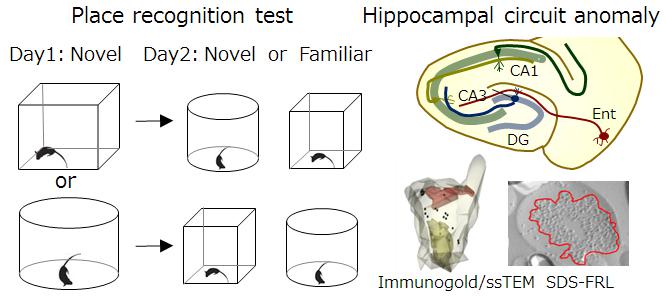Makoto Kinoshita (Nagoya University)

“Spatial discrimination impairment and adaptation in mice that genetically or postdevelopmentally lack a synaptic molecule from the entorhinal cortex-hippocampus circuit”
Recognition and discrimination of surrounding environments depends on the spatial pattern separation ― a neural process that requires the neural circuit between the entorhinal cortex and hippocampus, where the high-threshold glutamatergic synaptic inputs toward the granule cells of the dentate gyrus (DG) plays a critical role. Despite the theory/circuit-level understanding of the mechanism of the spatial pattern separation, underlying molecular mechanism remains unclear. Our unbiased behavioral screening of mice that lack a septin subunit showed their normal performance in spatial orientation, working memory, and tone-cued associative fear memory. Intriguingly, however, they selectively underperform in paradigms that require differentiation of distinct spatial contexts. To define brain regions and neuronal populations responsible for the phenotype, and to exclude possible developmental anomalies, we have conducted a local, acute depletion of the septin subunit in DG granule cells by injecting shRNA-expressing AAV vectors in adult mice, followed by spatial differentiation task. Successful recapitulation of the null phenotype demonstrates that acute, partial loss of the septin subunit in a subset of DG granule cells is sufficient to impair spatial cognition. The morphological and functional defects of the DG neurons in vivo and in vitro are under investigation.
Recent Publications
1. Ageta-Ishihara N, Kinoshita M et al., A CDC42EP4/septin-based perisynaptic glial scaffold facilitates glutamate clearance. Nature Communications 6:10090, 2015.
2. Hattori Y, Kinoshita M, Ihara M et al., SIRT1 counters cerebral hypoperfusion injury by deacetylating eNOS. Stroke 45, 3403-3411, 2014.
3. Ageta-Ishihara N, Bito H, Kinoshita M et al., Septins promote dendrite and axon development by negatively regulating microtubule stability via HDAC6-mediated deacetylation. Nature Communications 4, 2532, 2013.
4 Ageta-Ishihara N, Kinoshita M et al., Chronic overload of SEPT4, a parkin substrate that aggregates in Parkinson’s disease, causes behavioral alterations but not neurodegeneration in mice. Molecular Brain 6, 35, 2013.
5. Ihara M, Kinoshita M et al. Sept4, a component of presynaptic scaffold and Lewy bodies, is required for the suppression of α-synuclein neurotoxicity. Neuron 53, 519-533, 2007.
Posted:2016/03/10

